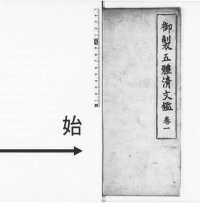
Ebook: Imperially-Published Five-Script Textual Mirror of Qing - Yù zhì wǔ tǐ Qīng wén jiàn
Author: Unknown
- Genre: Linguistics // Dictionaries
- Tags: #Pentaglot
- Year: 1957
- City: Beijng
- Language: Chinese
- pdf
The Yuzhi Wuti Qing Wenjian is organized into six boxes, containing 36 volumes on 2563 pages. The original work contained 32 volumes, with a four-volume supplement. It is divided into divisions (such as "Heaven Division"), category (such as "Astronomy"), with the categories further separated into types. There are 56 divisions, 318 categories, 616 types, with a total of 18671 terms. Each term has eight rows. From the top, the rows contain Manchu, Tibetan, a mechanical Tibetan transliteration into Manchu, a phonetic Tibetan transcription into Manchu, Mongolian, Chagatai, a transcription of Chagatai into Manchu, and Chinese.
For some terms, synonyms were included in the target languages (except Chinese). Thus, there are 19503 terms used in Mongolian corresponding to 18145 terms in Chinese (with 526 synonyms noted in Chinese). The Manchu text was largely based on the Beijing dialect of Manchu, using vertical regular script, with sentences terminated with punctuation (᠈ ), but no subsidiary pronunciation marks. Tibetan used the common written Tibetan usage at the time, in horizontal script in Uchen script (དབུ་མེད་), with terms that could not be written into a single line divided at syllabic boundaries, and terminating punctuation marks (།). Under the Tibetan was the Manchu transliteration, using Manchu phonemes to transliterate Tibetan letters to allow two-way transliteration and using distinctive characters for initial and medial phonemes; further, to transliterate some Tibetan letters, some new written forms for Manchu phonemes were invented (including initial "ng" and terminal vowels). Below the Manchu transliteration was the Manchu transcription to record the pronunciation in the Lhasa/Ü-Tsang dialect, due to the substantial difference between written Tibetan and spoken Tibetan. For Mongolian, the common written Mongolian of that time was used, in horizontal regular script, with punctuation marks at the end (᠈ ). Chagatai is written horizontally in Nastaʿlīq script, with terms that could not be written into a single line divided at syllabic boundaries and no terminal punctuations. Below Chagatai was Manchu transcription to record the eastern Xinjiang Turkic pronunciation,[6] due to the substantial difference between Chagatai and the spoken language of Xingjiang at the time; the sounds showed characteristics of the pronunciations used in the Hami/Turpan regions;[7] Chinese was spelled in traditional Chinese characters, also in vertical regular script, with the diction showing the influence of common usage in the Beijing Mandarin dialect. No punctuation or pronunciation marks were used.
For some terms, synonyms were included in the target languages (except Chinese). Thus, there are 19503 terms used in Mongolian corresponding to 18145 terms in Chinese (with 526 synonyms noted in Chinese). The Manchu text was largely based on the Beijing dialect of Manchu, using vertical regular script, with sentences terminated with punctuation (᠈ ), but no subsidiary pronunciation marks. Tibetan used the common written Tibetan usage at the time, in horizontal script in Uchen script (དབུ་མེད་), with terms that could not be written into a single line divided at syllabic boundaries, and terminating punctuation marks (།). Under the Tibetan was the Manchu transliteration, using Manchu phonemes to transliterate Tibetan letters to allow two-way transliteration and using distinctive characters for initial and medial phonemes; further, to transliterate some Tibetan letters, some new written forms for Manchu phonemes were invented (including initial "ng" and terminal vowels). Below the Manchu transliteration was the Manchu transcription to record the pronunciation in the Lhasa/Ü-Tsang dialect, due to the substantial difference between written Tibetan and spoken Tibetan. For Mongolian, the common written Mongolian of that time was used, in horizontal regular script, with punctuation marks at the end (᠈ ). Chagatai is written horizontally in Nastaʿlīq script, with terms that could not be written into a single line divided at syllabic boundaries and no terminal punctuations. Below Chagatai was Manchu transcription to record the eastern Xinjiang Turkic pronunciation,[6] due to the substantial difference between Chagatai and the spoken language of Xingjiang at the time; the sounds showed characteristics of the pronunciations used in the Hami/Turpan regions;[7] Chinese was spelled in traditional Chinese characters, also in vertical regular script, with the diction showing the influence of common usage in the Beijing Mandarin dialect. No punctuation or pronunciation marks were used.
Download the book Imperially-Published Five-Script Textual Mirror of Qing - Yù zhì wǔ tǐ Qīng wén jiàn for free or read online
Continue reading on any device:

Last viewed books
Related books
{related-news}
Comments (0)